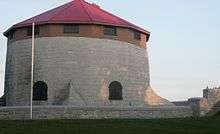Murney Tower
 | |
| Established | 1846 |
|---|---|
| Location | Murney Point, Kingston, Ontario, Canada |
| Type | Martello tower |
| Website | |
| Designated | 1930 |
| UNESCO World Heritage Site | |
| Reference | 1221-006 |
| Inscription | 2007 (31st Session) |
Murney Tower is a Martello tower in Kingston, Ontario, Canada, whose construction dates to 1846 and the Oregon crisis. While officially designated as Murray Tower, locals call it Murney Tower, as it was built on Murney Point (which was owned by the Murney family at the time). The Murneys have since relocated to the Cobourg area. Eventually the fort's name was changed to coincide with local usage.
Its builders intended that Murney (then Murray) Tower complement the fortifications of Fort Henry, Ontario, Cathcart Tower on Cedar Island, Shoal Tower in the Confederation Basin and Fort Frederick on the grounds of the Royal Military College of Canada. In addition to protecting the harbour and approaches to Kingston, these fortifications were designed to concentrate fire on Gardiners Island; it being the only place to effectively land artillery at the time. The tower stands surrounded by a dry-ditch and is accessible only by draw-bridge. Constructed of limestone, Murney's walls are about 3 metres thick on the land side and up to 5 metres thick on the lakeside. The main floor (ground level) was the barracks level and has two internal 32-lb caronade cannon directed out shuttered loops. These cannon could be moved about the interior embrasures, and so cover multiple approaches, including draw-bridge. The lower floor contained the ventilated magazine, storage, and infantry loopholes to scatter shot inside a dry-ditch. The uppermost level is the artillery platform which supports a large cannon (32-lbs) that could be rotated along an iron track, thus providing full coverage about the tower's circumference. A 'rapid removal' roof was later added to protect the gun and keep out the large amounts of snow that did not figure into the Mediterranean design of the tower. The addition of a roof is a common feature on Canadian Martellos.
Despite being state-of-the-art during construction, Murney Tower, along with most Martellos at this time, became rapidly obsolescent due to improvements made in gun, shot, and ship design. Because of this, and changes of military defense strategy, Murney was later converted into a familial barracks for an officer and his large family. After the turn of the previous century, habitation was discontinued and for a time there were no definite plans for the tower. One plan included removing the upper level of the tower and placing a large statue of Sir John A. MacDonald atop. In 1921 a windstorm removed the original wooden roof, and the replacement roof does not allow for rapid removal as originally intended.
Murney Tower is a National Historic Site of Canada,[1][2] managed and maintained by the Kingston Historical Society, who operates it as a military museum during the summer months (May — End of August). Displays include three cannon (32-lbs), period uniforms, muskets, and other mid 19th century military artifacts.
Although 16 Martello towers were built in Canada, only 11 are still standing, four of them in Kingston. Two of these towers, Murney Tower and Fort Frederick are open to the public and contain museums. Fort Frederick houses the Royal Military College of Canada Museum.
The tower is part of the Rideau Canal and Kingston Fortifications World Heritage Site.[3]
References
- ↑ Murney Tower, Directory of Designations of National Historic Significance of Canada
- ↑ Murney Tower. Canadian Register of Historic Places.
- ↑ http://whc.unesco.org/en/list/1221
- Kingston Fortifications national historic site of canada Management Plan (Ottawa: Parks Canada, 2006)
- Parks Canada, Murney Tower National Historic Site: Defending Our Past brochure, undated.
- Lavell, W.S., A Story in Stone: Murney Redoubt, 1963, undated revision by Richard Arthur Preston, Kingston, Ontario.
External links
- Murney Tower - Kingston Historical Society
Coordinates: 44°13′20″N 76°29′26″W / 44.22228°N 76.490582°W
